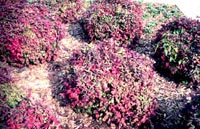Resource Library
Plant of the Week: Nandina, Dward (Gulf Stream)
The University of Arkansas System Division of Agriculture does not promote, support or recommend plants featured in "Plant of the Week." Please consult your local Extension office for plants suitable for your region.
Plant of the Week
Dwarf Nandina, 'Gulf Stream'
Latin: Nandina domestica

Gosh, gaudy is good. But enough already! Dwarf nandinas, those two-to-three foot glowing meatballs we see in every commercial landscape planting throughout the South, are beginning to make me see red.
I personally like the full-size nandina parent. I think it’s a wonderful landscape shrub, but one can only abide so many condensed mounds of red in the landscape. Like the llamas in Hilton’s Lost Horizon: Moderation in all things, please!
Nandina has long been a mainstay in the Southern landscape, but mostly it was the five-to-seven foot shrub that was used. Because this member of the barberry family grows from underground stems, it forms dense clusters of stems growing from the ground. It’s been grown in the U.S. since the early 19th century, and it’s always been popular where it’s hardy, from zones 6 through 9.
The dwarf forms of the plant are more recent in origin. They began showing up in the nursery trade in a big way after WWII.
‘Gulf Stream’ is one of a bevy of 25 or so dwarf nandinas on the market. It originated as a bud sport at Hines Nursery in Houston from the original dwarf form, ‘Atropurpurea Nana,’ which is a truly ugly plant with a thicket of upright stems. Gulf Stream has the triply pinnately compound leaves of the species. It produces blue-green summer foliage and bright red leaves in the fall and winter.
Being evergreen, this shrub will hold its leaves through the winter with the color persisting until new growth resumes. The transition from red winter color to green summer leaves is a yellowish blob that reminds me of some unpleasant experiences I’ve had during stomach flu season. Gulf Stream does not seem to flower or fruit, a decided drawback because the red wintertime berries are one of the most appealing aspects of nandinas.
The leaves of some dwarf nandina selections, but not Gulf Stream, will often be cupped and roll inwards or variously twisted. This is due to a virus infection that seems to be common through certain of the more dwarf strains. The virus, while not lethal, may cause the physiological dwarfing in some cultivars.
Dwarf nandinas seemed to have taken over the parking lot world in the early 1980's when nurseries learned how to propagate the dwarfs. Originally propagated only by division, the numbers were bearable. Tissue culture techniques, the propagation procedure where plants are grown aseptically in test tubes, was perfected, and almost overnight the dwarfs went from interesting novelties to landscape minion status.
What makes the dwarf nandinas popular in the landscape is their ability to survive parched or wet planting sites with almost equal success. They also give a good winter color display of bright red, at least in most years, and they are insect and disease free. Also, their midget size allows them to fit well in smaller landscapes.
But, still, there are too many of them. Perhaps their best use is as a color accent in a bed of green hollies where they can set off the positive attributes of both plants without overpowering the scene.
By: Gerald Klingaman, retired
Extension Horticulturist - Ornamentals
Extension News - December 8, 2000
The University of Arkansas System Division of Agriculture does not maintain lists of retail outlets where these plants can be purchased. Please check your local nursery or other retail outlets to ask about the availability of these plants for your growing area.